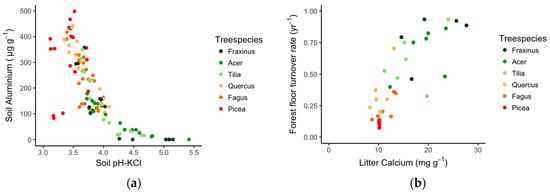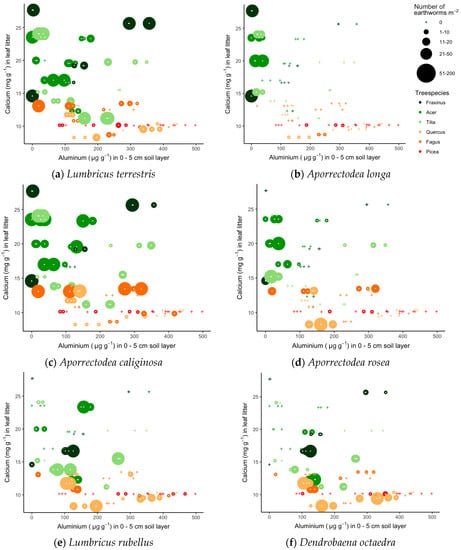It has come to our attention that there was a mistake in this paper [1]: namely, the units of soil cations K+, Na+, Mg2+, Ca2+ and Al3+ were written in mg·g−1 while they should have been in µg·g−1.
This mistake occurs in Table 1 on page 3 and Table A3 and Table A4 on page 15; and, in Figure 4a and Figure 5a–c on page 10 and Figure A1a–f on page 16.

Table 1.
Mean and standard deviation of topsoil (0–5 cm) properties for each tree species across all six common gardens. Significant differences between tree species are indicated with letters, means with the same letter are not significantly different (Tukey post-hoc tests on linear mixed-effects (LME) models, 1|Site).

Table A3.
Mean and standard deviation of the deeper soil (5–15 cm) properties for each tree species across all six common gardens. Significant differences according to the Tukey post-hoc test between tree species are indicated with letters, means with the same letter are not significantly different (Tukey post-hoc tests on LME models, 1|Site).

Table A4.
Mean and standard deviation of the deeper soil (15–30 cm) properties for each tree species across all six common gardens. Significant differences according to the Tukey post-hoc test between tree species are indicated with letters, means with the same letter are not significantly different (Tukey post-hoc tests on LME models, 1|Site).

Figure 4.
Relation between pH-KCl and exchangeable Al concentration in the 0–5 cm soil layer ((a) n = 105); In (b), the relation between Ca concentration in foliar litter and the forest floor turnover rate (n = 35) is shown. The points are colored according to the tree species. The foliar litter Ca concentration was previously published by Vesterdal et al. [36].


Figure 5.
Relation between exchangeable Al concentration in the 0–5 cm soil layer (a–c) or Ca concentration in foliar litter (d–f); and density of anecic (a,d); endogeic (b,e); and epigeic (c,f) earthworms. Plots where zero earthworms were found are indicated by a cross symbol. The foliar litter Ca concentration was previously published by Vesterdal et al. [36].

Figure A1.
The density of the most common earthworm species (anecic: L. terrestris (a) and A. longa (b); endogeic: A. caliginosa (c); A. rosea (d); and epigeic: L. rubellus (e) and D. octaedra (f)) in relation with exchangeable soil Al concentration and Ca concentration in litter. Earthworm density is shown by the size of the circles; a cross symbol indicates plots where no earthworms were found. The color of the circle indicates the tree species. The foliar litter Ca concentration was previously published by Vesterdal et al. [36].
Further, this correction is also needed in the following two lines: The line on page 11 “For the anecic species, A. longa was only scarcely present when soil Al concentrations were higher than 50 mg·g−1” should be “For the anecic species, A. longa was only scarcely present when soil Al concentrations were higher than 50 µg·g−1”; and, the line on page 11 “In our study, burrowing earthworm communities (endogeic and anecic species) appeared to be abundant when exchangeable soil Al concentrations were lower than 100 mg·g−1, and soil pH-KCl values were higher than about 4.” should be “In our study, burrowing earthworm communities (endogeic and anecic species) appeared to be abundant when exchangeable soil Al concentrations were lower than 100 µg·g−1, and soil pH-KCl values were higher than about 4.”
The authors would like to apologize for any inconvenience caused. The change does not affect the scientific results.
Here, we supply the corrected Tables and Figures.
Reference
- Schelfhout, S.; Mertens, J.; Verheyen, K.; Vesterdal, L.; Baeten, L.; Muys, B.; De Schrijver, A. Tree species identity shapes earthworm communities. Forests 2017, 8, 85. [Google Scholar] [CrossRef]
© 2017 by the authors. Licensee MDPI, Basel, Switzerland. This article is an open access article distributed under the terms and conditions of the Creative Commons Attribution (CC BY) license (http://creativecommons.org/licenses/by/4.0/).